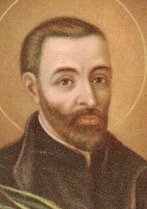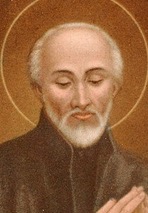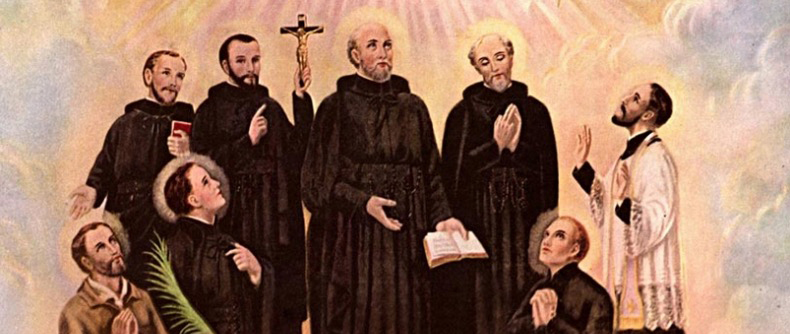“The blood of martyrs is the seed of Christians.”
This maxim, credited to the second-century ecclesiastical writer Tertullian, was profoundly evidenced by eight Jesuit missionaries who brought Jesus to the Indians of North America during the 17th century. In the face of extreme suffering and hardship, these brave Frenchmen met violent deaths while serving God and the Church in remote areas of eastern Canada and New York state. They became known as the North American Martyrs.
There were six priests and two oblate laymen, Jesuits all, who the Church raised to sainthood as a result of their heroic missionary efforts between the years 1625 and 1649. In an eight-year period (1642-1649), they were all murdered while spreading the Gospel to the North American Indians and as a group were canonized by Pope Pius IX in 1930. Their feast day is Oct. 19.
Although each of these missionaries had heard about the severe environment of the area called New France, none could fathom what the situation was actually like: disease, severe weather, lack of food, unsanitary living conditions, impassable forests, solitude and a hostile population. Travel was by canoe on treacherous waterways or walking for miles through dense insect-filled and uncharted forests. The Jesuit mission was to witness to a population of Indians who spoke a different language, were violent enemies and were not opposed to the use of torture.
Despite the anticipated hardships and often being urged not to go, the Jesuits sought out, some even begged for, missionary duties in North America.
Hurons and Iroquois
The Indians they sought to evangelize were primarily the Huron nation made up of between 20,000 to 30,000 people. The Hurons lived mostly in the interior of Canada, some more than 1,000 miles from the primary Jesuit mission center at Québec. While generally hospitable, the Indians were suspicious of the Black Robes (which the Indians called the Jesuits) and their religion. Among those who did eventually accept baptism, there was always an uncertainty as to whether or not the individual was totally or sincerely converted to Christianity. Many never completely gave up their old pagan traditions, and some even turned on the missionaries.
The Jesuits were mostly accepted by the Hurons, but that was not the case with the Iroquois, who hated both the Hurons and the French. The French were trade partners with the Hurons and, as such, sided with them against their longtime enemies, the Iroquois. Aggravating the situation was the fact that in 1613 the early French explorers had used muskets against the Iroquois’ bow and arrows, slaughtering many Indians. The Iroquois fostered their hatred for more than 100 years.
John de Brebeuf and Gabriel Lalemant

Father Gabriel Lalemont
The first of these Jesuits, Father John de Brebeuf, arrived in New France in 1625. Father Brebeuf was destined to become the founder of the Huron mission and has been referred to as the Apostle of the Hurons. He spent 24 years among the Indians and witnessed thousands of baptisms. Father Brebeuf worked hard at understanding the Huron language and actually prepared an invaluable dictionary as well as a catechism in the language. He had a special connection to the Hurons: they listened to his message about Jesus, and because of him, they allowed the Jesuits to baptize their children.
On March 16, 1649, Father Brebeuf and his Jesuit colleague Father Gabriel Lalemant were captured, severely tortured and murdered by marauding Iroquois. Their skin was cut off, hot irons were placed on their bodies and scalding water, mocking baptism, was poured over them. Kept alive for additional torture they were eventually tomahawked to death one day apart. Father Brebeuf is said to have suffered with such bravery that after killing him the Indians drank his blood and ate parts of his body seeking to acquire his courage. Father Lalemant followed Brebuef into the splendor of God’s kingdom on March 17.
Isaac Jogues and René Goupil

Father Isaac Jogues
The story of Father Isaac Jogues, another of the Jesuit martyrs, is unique. Arriving in New France in 1635, he soon was dispatched to the mission headed by Father Brebeuf near Lake Huron. Seven years into his active and effective ministry, on Aug. 16, 1642, Jogues and René Goupil, an oblate and surgeon, were captured by the Iroquois. They were beaten with clubs and burned with hot coals. Some of their fingers were chewed off at the knuckle, and the thumb of Jogues was severed from his right hand. Despite the awful torture, they both initially survived and attempted to witness to their captors. During captivity, Goupil made the Sign of the Cross on the head of an Iroquois baby and was immediately murdered with a tomahawk. The child’s parents had been told of Goupil’s actions and believed that the Sign of the Cross was evil.
After being imprisoned and used as a slave for 13 months, Father Jogues escaped and made his way back to France where he was treated as a hero. Because of his mutilated fingers and lack of a thumb, he believed the Church would not allow him to distribute the Body and Blood of Christ. Pope Urban VIII, however, made an exception for the courageous priest, and in 1646 Father Jogues eagerly returned to New France where he met his martyrdom.
John Lalande
Father Jogues and an oblate missionary, John Lalande, were attempting to affect peace between the French, the Hurons and the Iroquois when they were accused of being the cause of a bad harvest. They were taken prisoner and brutally tortured by Mohawk Indians, who were part of the Iroquois nation. On Oct. 18, 1646, a Mohawk brave killed Father Jogues with a hatchet. The next day, the courageous Father Lalande met the same fate.
Anthony Daniel
Father Anthony Daniel spent several years tirelessly instructing Huron youths at a seminary near Québec. He also repeatedly braved the wilderness, teaching the Christian faith and baptizing native Canadians. On July 4, 1648, after returning from one of his many exhausting trips and just finishing Mass, his mission at St. Joseph was attacked by an Iroquois war party; Father Daniel was murdered. Some accounts say he was shot with a musket and while still alive crawled among other victims bringing comfort, baptizing and giving absolution. Eventually, he was killed by a hatchet to his head.
Charles Garnier
In the same year that Fathers Brebeuf and Lalemant were martyred, a fellow Jesuit priest, Father Charles Garnier, was also murdered. He served in Canada for 13 years and like his Jesuit comrades performed his sacred ministry despite hunger, insults, deplorable living conditions and the ever present threat of death. Reports are that he would walk 30 miles a day in either heat or cold to spread the Gospel, lived in squalor and filth with the natives while caring for their sick and never counted the cost. On Dec. 7, 1649, he was born to heaven after being struck by a tomahawk during an Iroquois attack.
Noël Chabanel
The next day, the feast of the Immaculate Conception, Father Noël Chabanel was returning to the mission hub at Sainte Marie, Canada, when he was killed, allegedly by one of his Huron converts. Among the Jesuits, Father Chabanel had experienced the most difficulties with the assignment. He disliked the Indian culture, never mastered the language and was often depressed. Despite these problems, which would have caused a lesser man to return home, Father Chabanel took a vow to never forsake his missionary duties or to deny the martyrdom he anticipated. He was the last of the eight Jesuits to die.
Scholars and writers have long debated the impact of the Jesuits in the overall history of New France. What can’t be debated is the well-documented story of eight heroic and faith-filled Frenchmen who never doubted they were planting the seed of Christianity and bringing Jesus Christ into the world of the Indian. Their zeal, courage and willingness to sacrifice to the point where they laid down their lives to witness for Jesus is a shining star on the North American continent and in the Church.
D.D. Emmons writes from Mount Joy, Pa.
North American Martyrs
- Father John de Brebeuf (1593-1649)
- Father Noël Chabanel (1613-1649)
- Father Antony Daniel (1601-1648)
- Father Charles Garnier (1606-1649)
- Oblate René Goupil (1608-1642)
- Father Isaac Jogues (1607-1646)
- Oblate John de Lalande (died 1646)
- Father Gabriel Lalemant (1610-1649)

